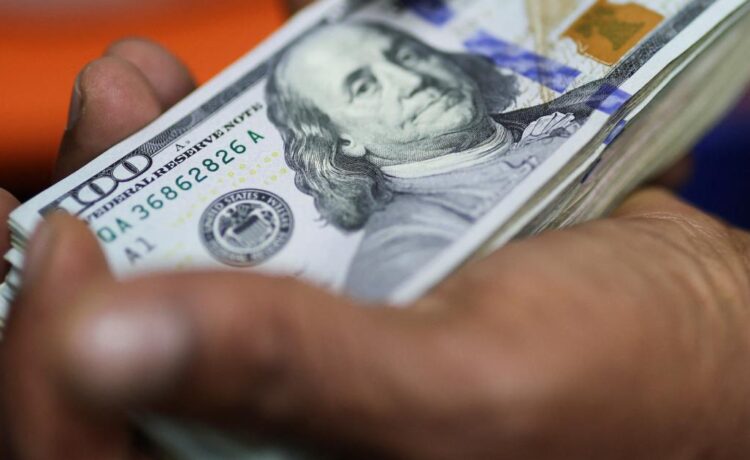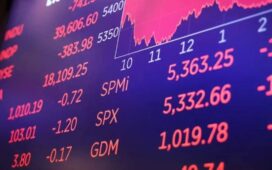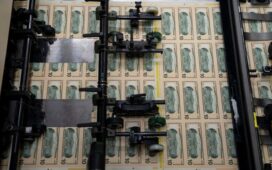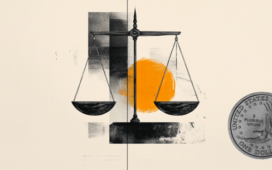Last year, the United States appeared to be consolidating its pole position as a haven for international investment. The U.S. economy’s remarkable strength relative to other major economies helped account for a nearly ten percent surge in the dollar’s value in the fall of 2024. The economy and labor market continued to perform well leading up to and following Donald Trump’s inauguration. And inflation was gradually falling back toward the Federal Reserve’s target of about two percent.
But since he came into office, Trump has sowed doubt among both domestic and foreign investors. His “Liberation Day” announcement, on April 2, of across-the-board tariffs on all U.S. trading partners disrupted global trade and roiled financial markets. Even though the White House has paused or lowered some of those tariffs from their initial sky-high levels, the damage has been done. The uncertainty the tariffs fomented in international trade has hurt growth prospects for the remainder of this year. This is true in particular for the United States, because the tariffs affect virtually all U.S. trade. Consequently, it has become more likely that the Federal Reserve will have to cut interest rates later this year to support the economy. This, in turn, has caused the value of the dollar to fall roughly back to its September 2024 level, before its ten percent increase.
These developments have even raised questions about the dollar’s historic role as a refuge for international investment. In the past two decades, every instance of economic and financial turmoil resulted in a mad dash by investors around the world for safe financial assets in which to park their money while the storm blew over. As I argued in Foreign Affairs last summer, those instances invariably featured swelling demand for U.S. Treasury securities, long seen as the safest of assets because of the U.S. economy’s stability and because these securities are available in large quantities and easily tradable. This higher demand typically pushes up the price of Treasury securities and drives down their interest rates, making it easier for both the U.S. government and American households to borrow cheaply. The inflow of money into dollar assets also props up the dollar itself.
After Trump’s tariffs announcement, the reaction was different. Panicked investors seemed to prefer not U.S. Treasuries or other assets denominated in dollars but alternatives, such as Japanese government bonds and gold. Unlike in other recent episodes of turmoil, U.S. long-term interest rates spiked, especially the yield on the ten-year Treasury note, which serves as a benchmark for auto, mortgage, and business loans in the United States. Moreover, the dollar’s value against other currencies—which had been stable during past unravelings of U.S. financial markets—fell.
With his economic policies, his attack on the Federal Reserve’s independence, and the damage he’s done to the rule of law in the United States, Trump has endangered not only the strength of the dollar in foreign exchange markets but also the institutional framework that underpins the currency’s longer-term dominance. Such conditions suggest that a reckoning is surely at hand for the dollar, which has lorded over international finance as the dominant invoicing, payment, and reserve currency for more than a century. That Trump has floated the idea of seeking other countries’ cooperation to weaken the dollar—in a wishful bid to boost U.S. exports—only underlines the danger.
And yet the dollar’s dethroning, a prospect that has long excited U.S. allies and adversaries alike, is unlikely if other countries don’t seize the opportunity to supplant it. It appears that they are unprepared to do so. Despite Trump’s weakening of the United States’ economic position, investment assets in other major economies, including China, Japan, and the eurozone, remain less attractive relative to those in the United States. In some cases, these countries’ weaker economic growth prospects have made their assets less alluring. In the eyes of investors, China is also hamstrung by both the restricted mobility of capital into and out of the country and the lack of independence of the Chinese central bank. Europe’s own political turbulence, meanwhile, raises questions about the eurozone’s stability.
The U.S. dollar’s position at the top of the world’s monetary system has never looked more tenuous. Luckily for the United States—and unfortunately for the dollar’s detractors—there appears to be no competitor strong enough to bump it off its pedestal.
RACE TO THE BOTTOM
It is still unclear whether the global rush toward non-U.S. assets that quickened earlier this year marks the beginning of a trend or simply reflects technical and macroeconomic factors. The shifts in projections of U.S. growth and interest-rate levels brought on by Trump’s tariffs announcement, for example, forced hedge funds that had taken highly leveraged bets on U.S. Treasuries to sell their stakes once those bets went awry. Macroeconomic forces have pushed in the same direction, leading purchasers of U.S. government debt to demand higher interest rates, an indicator that they anticipate higher inflation. With the United States on track to increase its already astronomical federal debt level and with the announced tariffs likely to push up inflation, it is small wonder that interest rates on the government’s borrowing have risen, despite the prospect of a growth slowdown, which would normally push rates down.
The shift away from dollar assets might also be driven by investors wanting to diversify their holdings. For foreign investors, whether they are private or official—with the latter category including central banks and sovereign wealth funds—holding more than 50 percent of a portfolio in the assets of one country or denominated in that country’s currency makes little sense. Such a high degree of concentration exposes investors to economic, financial, and geopolitical risks, all of which have intensified since Trump took office. Therefore, the purchase of non-U.S. assets might simply indicate an opportunistic shift by global investors toward the sensible goal of diversification.
But this shift could reach its limits soon, because other countries’ currencies and financial markets simply lack the depth (the availability of great quantities of high-quality assets) and liquidity (the easy tradability of those assets) to support large inflows of capital. Similarly, although technological changes helping link different countries’ payment systems with one another as well as the desires of global investors to diversify might erode the dollar’s role as a payment currency for international transactions, there is little evidence so far that this is happening. The dollar continues to maintain a wide lead over all other currencies.
This lead is shrinking, however. History shows that the forces that can precipitate a sharp shift in a country’s relative financial and currency power can accumulate over time, with the final switch occurring quickly. Consider the damage Trump is inflicting on the U.S. institutional framework, which is one of the crucial bulwarks underpinning both the dollar’s dominance and the trust of domestic and foreign investors in the dollar-based financial system. Trump’s degradation of the rule of law and his erratic policymaking should prompt foreign governments and central banks to lower their reliance on the dollar as an international payment and reserve currency, as should Trump’s attacks on the independence of the United States’ central bank. He has not only pressured the Federal Reserve to cut interest rates but has also signaled that he may appoint to it more pliable senior officials who will do his administration’s bidding on monetary policy and regulatory matters. His direct assault on the Federal Reserve’s autonomy will have serious implications for the institution’s ability to deliver on its mandates of maintaining low inflation and unemployment, which is a crucial driver of foreign investors’ trust in the long-term value of the dollar.
LONELY AT THE TOP
It is premature, though, to write an obituary for the dollar’s dominance, considering the fragilities of other reserve currencies and the enormous demand for safe financial assets at a time of economic and financial turmoil. The Japanese government bond market is certainly deep and is widely regarded as safe, as are bond markets in some of the core eurozone economies, such as Austria, France, Germany, and the Netherlands. But each of these alternatives is beset by weak growth prospects or turbulent domestic politics. The eurozone, for example, has made little progress in recent years toward greater economic and financial integration, and its core economies have taken a populist, rightward turn, presaging political instability. Such developments, along with rising budget deficits in these economies, hardly inspire confidence in investors for strong, stable growth.
China’s economy is finally having to come to terms with its internal fragilities, too. The unraveling of the country’s property markets continues to cause strains. The financial risks from its growth model, characterized by a heavy dependence on inefficient investment financed by bank credit, have become apparent to investors. China also remains unable to shake the specter of deflation stemming from how its production capacity has outpaced domestic consumer demand for its products in recent years. Household and private-business confidence in the government’s policies and economic management have crumbled. And China hardly has the trust of foreign investors because of its weak institutional framework, with the Chinese Communist Party maintaining an iron grip over the country’s economic, legal, and political systems.
Even as the U.S. dollar’s perch at the apex of the international monetary system looks increasingly fragile, the lack of viable alternatives should keep it from tumbling off that perch—for now. As has long been the case, this resilience is less a product of American exceptionalism than of fundamental economic, political, and institutional weaknesses in the rest of the world. Unless that changes, the dollar will remain on a much longer leash than any currency should rightfully have.
Loading…





